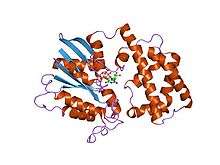Regulator of G protein signaling
| Regulator of G-Protein Signaling Domain | |||||||||
|---|---|---|---|---|---|---|---|---|---|
 Structure of active conformation of Gi-alpha1[1] | |||||||||
| Identifiers | |||||||||
| Symbol | RGS | ||||||||
| Pfam | PF00615 | ||||||||
| InterPro | IPR000342 | ||||||||
| SMART | RGS | ||||||||
| PROSITE | PDOC50132 | ||||||||
| SCOP | 1gia | ||||||||
| SUPERFAMILY | 1gia | ||||||||
| OPM protein | 2bcj | ||||||||
| CDD | cd07440 | ||||||||
| |||||||||
Regulators of G protein signaling (or RGS) are protein structural domains that activate GTPases for heterotrimeric G-protein alpha-subunits.
RGS proteins are multi-functional, GTPase-accelerating proteins that promote GTP hydrolysis by the alpha subunit of heterotrimeric G proteins, thereby inactivating the G protein and rapidly switching off G protein-coupled receptor signaling pathways.[2] Upon activation by receptors, G proteins exchange GDP for GTP, are released from the receptor, and dissociate into a free, active GTP-bound alpha subunit and beta-gamma dimer, both of which activate downstream effectors. The response is terminated upon GTP hydrolysis by the alpha subunit (InterPro: IPR001019), which can then re-bind the beta-gamma dimer (InterPro: IPR001632 InterPro: IPR001770) and the receptor. RGS proteins markedly reduce the lifespan of GTP-bound alpha subunits by stabilising the G protein transition state. Whereas receptors stimulate GTP binding, RGS proteins stimulate GTP hydrolysis.
RGS proteins have been conserved in evolution. The first to be identified was Sst2 ("SuperSensiTivity to pheromone") in yeast (Saccharomyces cerevisiae).[3] All RGS proteins contain an RGS-box (or RGS domain), which is required for activity. Some small RGS proteins such as RGS1 and RGS4 are little more than an RGS domain, while others also contain additional domains that confer further functionality.[4]
RGS domains can be found within the same protein in combination with a variety of other domains, including: DEP for membrane targeting (InterPro: IPR000591), PDZ for binding to GPCRs (InterPro: IPR001478), PTB for phosphotyrosine-binding (InterPro: IPR006020), RBD for Ras-binding (InterPro: IPR003116), GoLoco for guanine nucleotide inhibitor activity (InterPro: IPR003109), PX for phosphoinositide-binding (InterPro: IPR001683), PXA that is associated with PX (InterPro: IPR003114), PH for phosphatidylinositol-binding (InterPro: IPR001849), and GGL (G protein gamma subunit-like) for binding G protein beta subunits (InterPro: IPR001770 Those RGS proteins that contain GGL domains can interact with G protein beta subunits to form novel dimers that prevent G protein gamma subunit binding and G protein alpha subunit association, thereby preventing heterotrimer formation.
Examples
Human proteins containing this domain include:
- ADRBK1, ADRBK2, AXIN1, AXIN2
- GRK1, GRK4, GRK5, GRK6, GRK7,
- RGS1, RGS2, RGS3, RGS4, RGS5, RGS6, RGS7, RGS8, RGS9, RGS10, RGS11, RGS12, RGS13, RGS14, RGS16, RGS17, RGS18, RGS19, RGS20, RGS21
- RK
- SNX13
See also
GTP-binding protein regulators:
References
- ↑ Coleman DE, Berghuis AM, Lee E, Linder ME, Gilman AG, Sprang SR (September 1994). "Structures of active conformations of Gi alpha 1 and the mechanism of GTP hydrolysis". Science. 265 (5177): 1405–12. PMID 8073283. doi:10.1126/science.8073283.
- ↑ De Vries L, Farquhar MG, Zheng B, Fischer T, Elenko E (2000). "The regulator of G protein signaling family". Annu. Rev. Pharmacol. Toxicol. 40: 235–271. PMID 10836135. doi:10.1146/annurev.pharmtox.40.1.235.
- ↑ Dohlman HG (2009). "RGS proteins the early days". Prog. Mol. Biol. Transl. Sci. 86: 1–14. PMID 20374711. doi:10.1016/S1877-1173(09)86001-8.
- ↑ Burchett SA (2000). "Regulators of G protein signaling: a bestiary of modular protein binding domains". J. Neurochem. 75 (4): 1335–1351. PMID 10987813. doi:10.1046/j.1471-4159.2000.0751335.x.
Further reading
- Tesmer, JJ; Berman, DM; Gilman, AG; Sprang, SR (1997). "Structure of RGS4 bound to AlF4--activated G(i alpha1): Stabilization of the transition state for GTP hydrolysis". Cell. 89 (2): 251–61. PMID 9108480. doi:10.1016/s0092-8674(00)80204-4.
- Hunt TW, Fields TA, Casey PJ, Peralta EG (September 1996). "RGS10 is a selective activator of G alpha i GTPase activity". Nature. 383 (6596): 175–7. PMID 8774883. doi:10.1038/383175a0.
- Watson N, Linder ME, Druey KM, Kehrl JH, Blumer KJ (September 1996). "RGS family members: GTPase-activating proteins for heterotrimeric G-protein alpha-subunits". Nature. 383 (6596): 172–5. PMID 8774882. doi:10.1038/383172a0.
- Berman DM, Wilkie TM, Gilman AG (August 1996). "GAIP and RGS4 are GTPase-activating proteins for the Gi subfamily of G protein alpha subunits". Cell. 86 (3): 445–52. PMID 8756726. doi:10.1016/S0092-8674(00)80117-8.
- Koelle MR, Horvitz HR (January 1996). "EGL-10 regulates G protein signaling in the C. elegans nervous system and shares a conserved domain with many mammalian proteins". Cell. 84 (1): 115–25. PMID 8548815. doi:10.1016/s0092-8674(00)80998-8.
- De Vries L, Mousli M, Wurmser A, Farquhar MG (December 1995). "GAIP, a protein that specifically interacts with the trimeric G protein G alpha i3, is a member of a protein family with a highly conserved core domain". Proc. Natl. Acad. Sci. U.S.A. 92 (25): 11916–20. PMC 40514
 . PMID 8524874. doi:10.1073/pnas.92.25.11916.
. PMID 8524874. doi:10.1073/pnas.92.25.11916. - Dohlman H, Apaniesk D, Chen Y, Song J, Nusskern D (July 1995). "Inhibition of G-protein signaling by dominant gain-of-function mutations in Sst2p, a pheromone desensitization factor in Saccharomyces cerevisiae". Mol Cell Biol. 15 (7): 3635–43. PMC 230601
 . PMID 7791771.
. PMID 7791771. - Siderovski DP, Hessel A, Chung S, Mak TW, Tyers M (February 1996). "A new family of regulators of G-protein-coupled receptors?". Curr Biol. 6 (2): 211–2. PMID 8673468. doi:10.1016/S0960-9822(02)00454-2.
External links
- in PROSITE